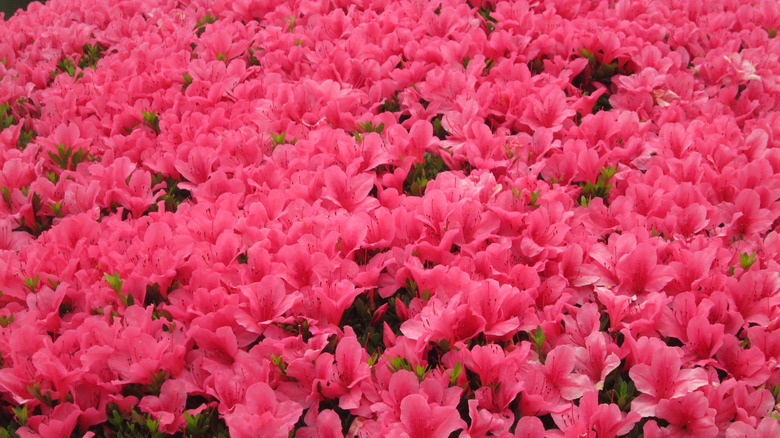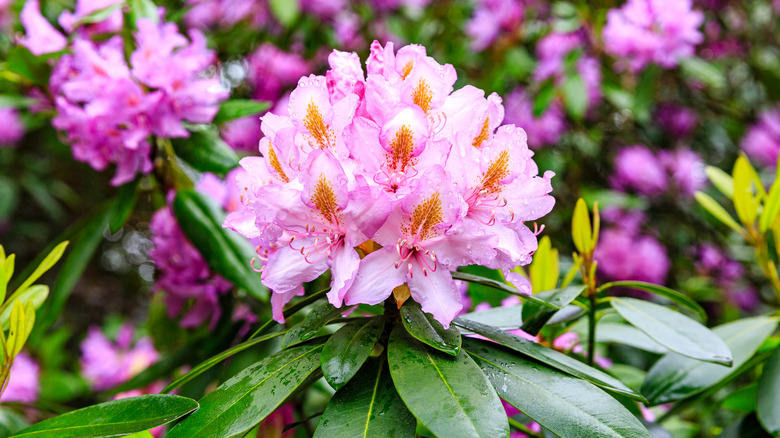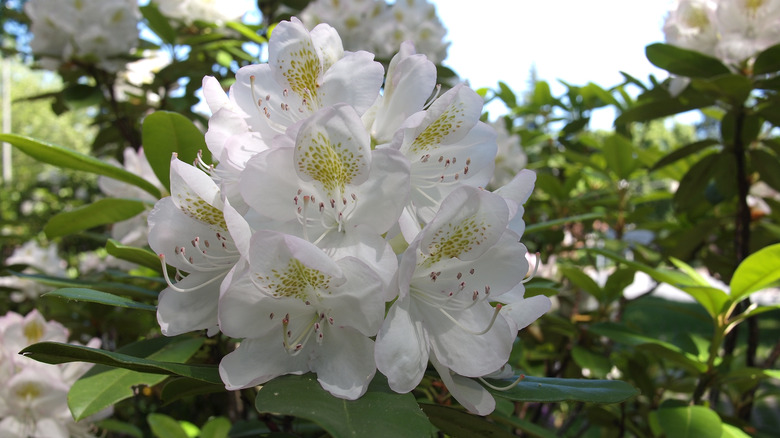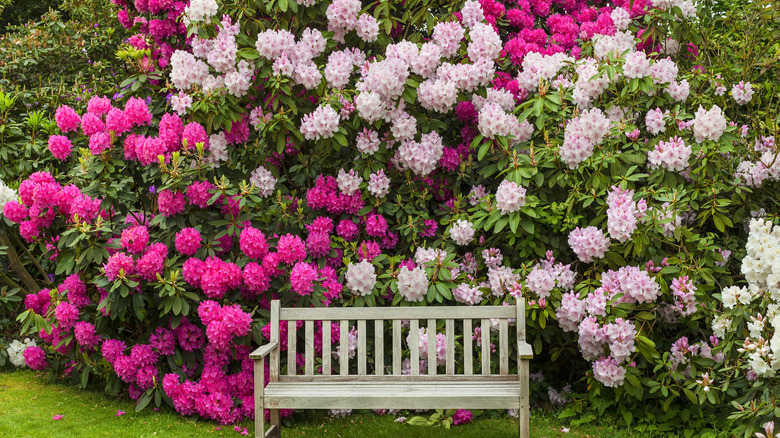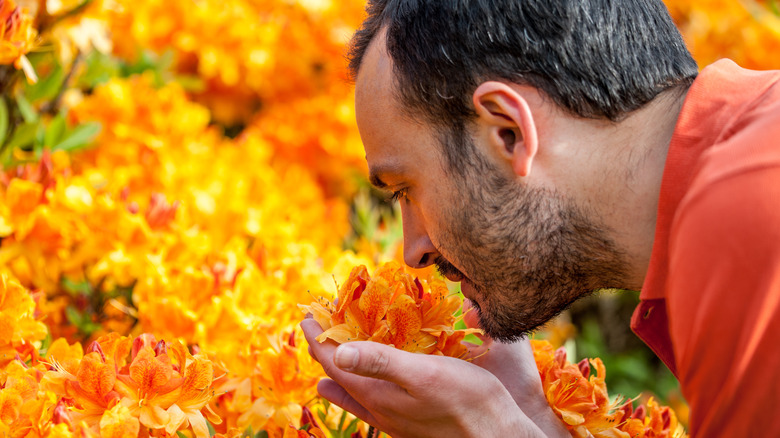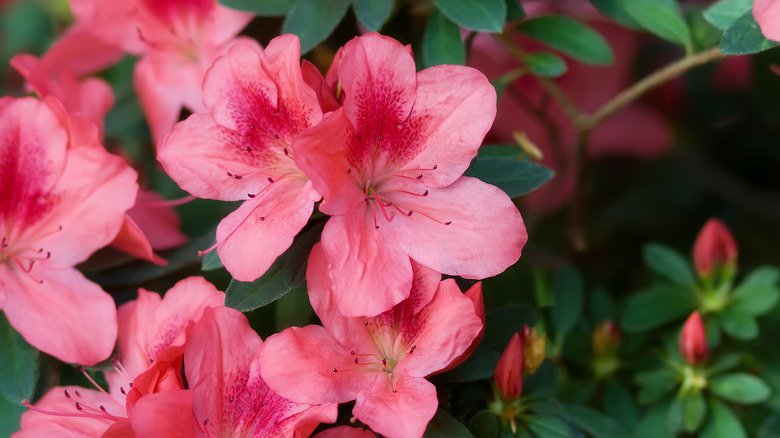Rhododendron Bush: Everything You Should Know Before Planting
A beautiful, thriving, and hearty shrub can be the one perfect addition to your home's exterior that sets the whole aesthetic into place. A large, colorful bush is also a great way to fill in any gaps between other plants, cover up bare foundation spots, or simply add a statement plant to your garden's mix.
The rhododendron bush is the perfect example of such a plant. The bright pink and purple flowering bush is from the Ericaceae family, via the ASPCA, and its common name is actually the same as its scientific name. (A relative, the azalea, is also from the genus Rhododendron, and has very similar looking flowers.) The plant is also the state flower and symbol of West Virginia.
According to The Old Farmer's Almanac, the rhododendron's flowers are typically cylindrical in shape, either tube, funnel, or bell-shaped. Rhododendrons also produce more fragrant flowers compared to some other plants, and have leaves that are large and leathery. Here's everything that you need to know before planting rhododendron bushes.
How to grow rhododendron bushes
Rhododendrons can be fairly easy to grow in the right environments, though environment is definitely a huge factor in whether they thrive or not. According to HGTV, many people often confuse rhododendrons and azaleas, and though they are from the same family, they are very different plants. There is definitely a difference in size, as well as in which areas each will thrive. Rhododendrons will thrive in regions like the Pacific Northwest and the Northeast, doing better in colder temperatures but also preferring climates that are not too hot, too cold, too dry, or too humid.
Better Homes & Gardens points out that rhododendrons prefer soil that is more acidic and that is rich in organic material, and does best in soil that does not completely dry out but also doesn't retain too much moisture. HGTV also suggests buying your rhododendron plants in one or three-gallon pots from the nursery and planting in spring or early fall. As a tip, planting rhododendrons in the fall will typically result in healthier, hardier, stronger roots. You will want to plant your rhododendron in a spot that gets dappled sun/shade — avoid areas that get full sun or little to no sun. You will also want to plant each plant (if you buy multiple) about two to six feet apart.
How to care for rhododendron bushes
Once planted, rhododendrons are fairly easy to take care of, so long as you've met the soil and site requirements for planting. The Clemson Cooperative Extension Home & Garden Information Center emphasizes the need for good soil irrigation during dry periods for successful rhododendron cultivation, and that newly planted rhododendrons need regular watering during dry spells for the first several years of growth. Rhododendrons also require around six hours of sunlight a day, but not full, direct, or hot afternoon sun.
According to Gardening Know How, you should fertilize your rhododendron every year and mulch is a great way to add organic material to your soil, but avoid peat moss as it does not rewet easily once it dries out. The importance of pruning is also stressed to both keep a uniform shape of your rhododendron bush as it grows upward and outward, but also to keep the whole plant healthy. Deadheading flowers is also really important to ensure healthy growth for the following year.
How to use rhododendron bushes in garden
As mentioned, rhododendrons are beautiful, full, and often vibrant plants that can add a ton of color and shape to your garden. According to HGTV, purchasing rhododendron bushes in 1- or 3-gallon pots and spacing them 2 to 6 feet apart in your garden will maximize results for when they mature and bloom. Moreover, deciding on which rhododendron variety is best for your specific garden needs will partially depend on how large your plants will be at full maturity. Some varieties, like Purple Gem, only grow to be about 2 feet tall whereas varieties like Nova Zembla can grow anywhere from 5 to 10 feet tall.
If you're still planning out your garden, there are certainly a lot of options to choose from when attempting to incorporate rhododendron bushes. Better Homes & Gardens' top two suggestions for planting rhododendrons are using them in foundation gardens or as mixed borders that provide foliage year-round. Foundation planting helps cover unsightly foundation cement or other undesirable spots along the base of a house, and mixed borders can help blend a yard with wooded areas or simply create spots of aesthetically-pleasing foliage.
Are rhododendron bushes toxic?
In a short answer: yes, rhododendrons fall under the "toxic plants" category. According to the Poison Control Center, it's believed that a member of the rhododendron family may have been the source of one of the first-ever mass poisonings. While the most major concentrations of the toxin are found in honey made by bees from rhododendron flowers, the plant is also toxic if ingested in any way (e.g., the nectar, leaves, or flowers). The poisonous honey has earned the nickname "mad honey" because of its tendency to cause confusion when ingested. Additionally, ingesting any part of a rhododendron plant can cause mouth irritation, nausea, and vomiting, though in more severe and sometimes life-threatening cases, it can cause low blood pressure, low heart rate, or irregular heart rhythm.
The ASPCA notes that rhododendrons are toxic to dogs, cats, and horses, which makes sense if ingesting the plant is potentially life-threatening for humans. It is suggested that, whether you have rhododendrons in an outdoor garden or for décor inside the house, you keep a close eye on all children and pets to ensure no one ingests any part of the plant.
Rhododendron bushes vs. azaleas
It's easy to confuse rhododendrons and azaleas as both plants look very similar. That's probably due to the fact that both plants are from the same Rhododendron genus, per Piedmont Master Gardeners. One might say that a rhododendron is the face of the plant genus while azaleas are technically considered a subspecies. So while every azalea is a rhododendron, not every rhododendron is an azalea.
However, there are definitely some differences, though small, between the two plants. For example, rhododendrons are typically bigger and have larger blooms and leaves than azaleas, and they are also more resilient in cold temperatures. Rhododendrons will thrive in areas like the Pacific Northwest and Northeast, whereas azaleas do better in the hot and humid climates of the South and Southern coast.
The Spruce also notes that azalea blooms generally have five stamens but rhododendrons have ten, and many azaleas are deciduous, though rhododendrons are almost entirely evergreen. If bloom time is an important factor for your own garden, you should know that azaleas typically bloom in early April, but rhododendrons bloom later in the spring, closer to summer. It's also believed that azaleas offer a wider range of colors than rhododendrons do, when bloomed.
